|
(A.K.A. As "Mule Ear" and Improved Jenks Carbine)
|
|
|
|
|
|
|
|
|
|
|
| This
carbine is .54 caliber with six groove rifling. The overall measurement,
in a straight line from the heel of the butt to the bottom of the
barrel front, is 40¾". The barrel length is 24¼".
The black walnut stock ends 1-3/16" from the barrel muzzle. The
tang and breech strap lever measure 6-3/8" from the front of the
breech to the rear of the tang. The lock length is 6-5/8". It is
equipped with a tape primer device.
|
|
|
|
|
|
William Jenks entered into a contract with the Navy on September
22, 1845 for 1,000 of his carbines to be equipped with the Maynard
tape priming device . He had four previous Navy contracts dating
from 1841 to 1846 for about 4,250 of his initial side hammer percussion
"mule ear" carbines. These earlier weapons were manufactured by
N.P. Ames of Springfield, Mass. from 1841 to 1846. In 1846, the
final contract was purchased from Ames along with William Jenks,
personally and most of the carbine making equipment by E. Remington
of Herkimer N.Y. who completed the contract obligations. Remington
then filled the contract of September 22, 1845 calling for 1,000
Maynard tape equipped carbines. These arms were not a conversion
of the original Jenks carbines, but wholly new carbines with the
inventor himself supervising the entire production of this well
made and handsome arm.
|
|
|
It should be noted that one of the former Ames employees who accompanied
Jenks to Herkimer, N.Y. was Fordyce Beals, a highly accomplished
mechanic and armorer who would later put Remington into the arms
making fore-front by his design of the Beals and Remington revolvers.
|
|
|
|
|
|
|
|
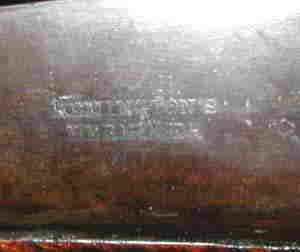
|
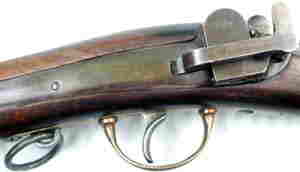
|

|
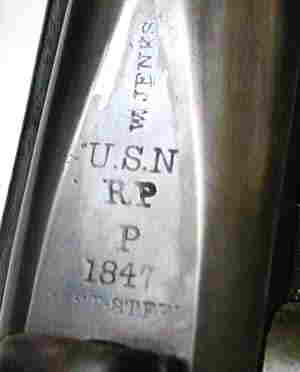
|
|
The lockplate is stamped rather faintly. It reads "REMINGTON'S/HERKIMER/
N.Y." in three horizontal lines. The barrel markings are "W. JENKS",
stamped lengthwise on the barrel, over the four line upright stamping
of "U.S.N/RP/P/1847/CAST-STEEL". "RP" was Richard Paine, the inspector.
The separate "P" is for proofed.
|
|
|
|
|
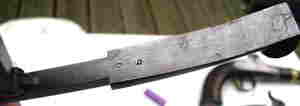
|
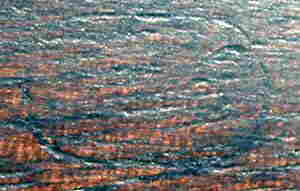
|
|
The only other legible marking found on this carbine is the serial
number "96" which is stamped on the bottom inside of the breech
lever. If one uses their imagination, a hardly visible cartouche
can be seen on the left side of the stock more or less opposite
the lock.
|
|
|
|
|
|
|
|
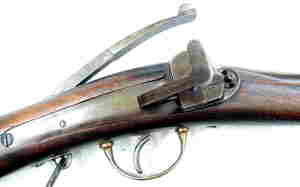
|
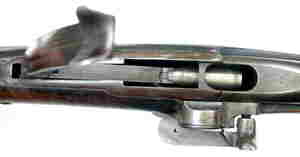
|
|
The Jenks-Remington carbine operated in the same manner as the earlier
Jenks. The breech lever when raised, draws the sliding bolt rearward,
opening the chamber for loading of the wrapped powder charge and
round ball. Lowering the breech lever moves the bolt forward placing
the powder charge under the priming vent (nipple) on the right side
of the barrel. The cocking of the side swing (mule ear) hammer outward
actuates the Maynard priming tape into position under the hammer.
|
|
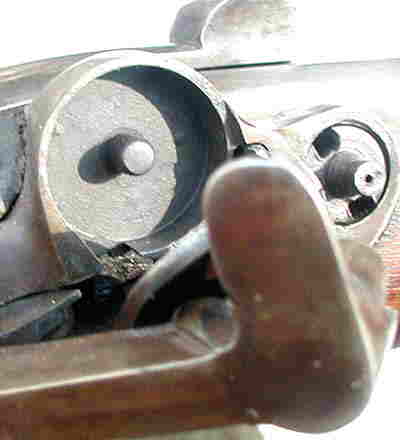
|
|
|
The door of the Maynard priming device can only be opened when the
weapon is cocked.
|
|
|
|
|
|
|
|

|
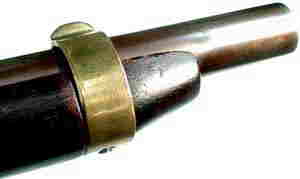
|
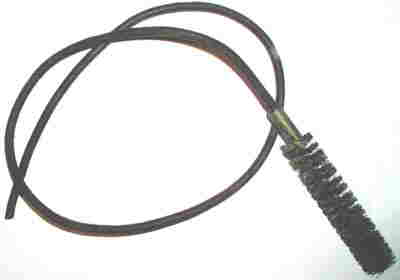
|
|
|
A sling ring is attached to the rear of the brass trigger guard.
The stock ends 1¾" from the muzzle. As can be seen, the weapon
is not fitted for a ramrod. A cleaning brush attached to a cord
was used for swabbing out the barrel. A typical carbine cleaning
brush is pictured. It is not necessarily a Jenks cleaning brush.
|
|
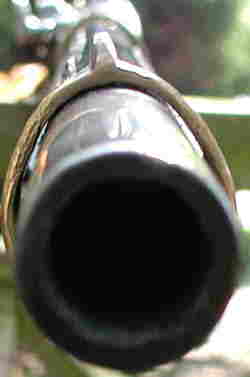
|
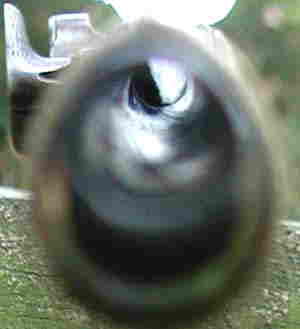
|
|
|
|
|
|
|
|
|
|
|
Navy records as detailed in "CIVIL WAR SMALL ARMS OF THE U.S. NAVY
AND MARINE CORPS" by John D. McAulay indicate that by 1861 these
carbines were in inventory only at some Navy Yards. Official memos
stated that they were not to be issued unless no other arms were
available. None were noted to be in the inventory of any ships after
that date. However, this carbine served as a companion piece to
the Model 1842 Single Shot Percussion Navy Boxlock pistol before
and during the War with Mexico as well as in the far east and all
other countries that the U.S. fleet and Marines visited.
|
|
|
Civil War usage, if any, would have been minimal. It is not known
if any of these carbines found their way into southern armories
or onto southern ships.
|
|
|
References used for this posting are "UNITED STATES MILITARY SMALL
ARMS 1816 - 1865" by Robert M. Reilly, "FLAYDERMAN'S GUIDE TO ANTIQUE
AMERICAN FIREARMS...AND THEIR VALUES" by Norm Flayderman and "CIVIL
WAR SMALL ARMS OF THE U.S. NAVY AND MARINE CORPS" by John D. McAulay.
Some descriptions are verbatim.
|
|
| My
thanks, once again, to my webmaster and son, Reed Radcliffe.
Dave Radcliffe
|
|

